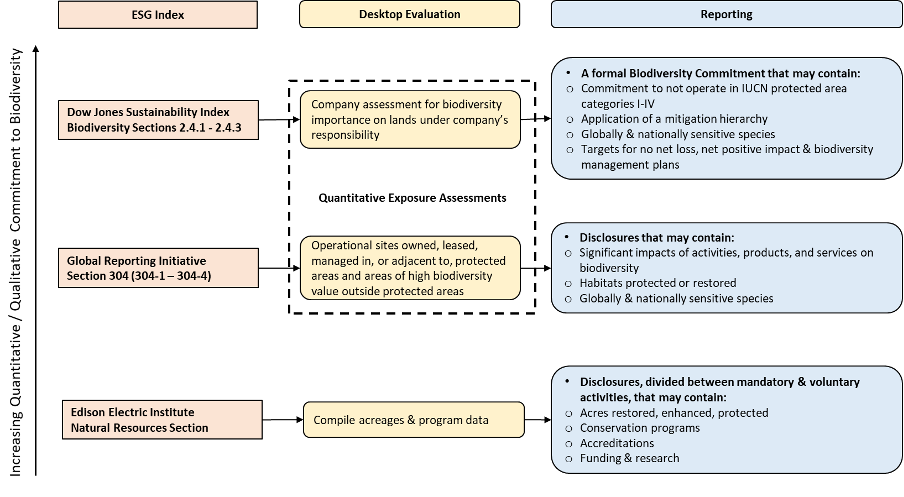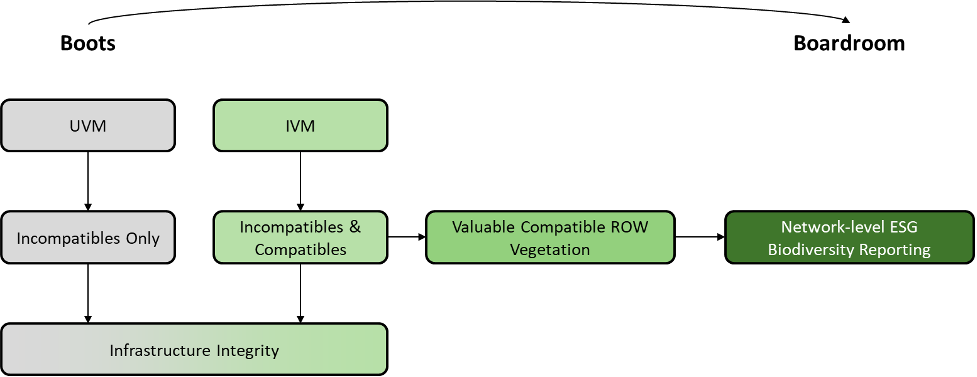Boots to the Boardroom – Leveraging ESG Biodiversity Sections for IVM Programming
September / October 2020
Drag to resize
This article introduces the main Environmental, Social and Governance (ESG) biodiversity reporting options available for utilities with existing and evolving integrated vegetation management (IVM) programs, and it provides recommendations for developing and strengthening quantifiable conservation frameworks based on disclosures outlined within the most stringent of ESG indices. Utilities can link their intentional vegetation management activities, from boots to the boardroom, by creating a structured framework that encourages boots to manage for valuable compatible right-of-way (ROW) vegetation through IVM that links value-driven monitoring to quantifiable ESG reporting.
Utility vegetation management (UVM) has a long and varied history, as does IVM, but the two are not necessarily the same. UVM’s primary objective is to maintain infrastructure integrity through the elimination of incompatible vegetation. IVM shares the same primary objective but adds intentional management of compatible vegetation. IVM activities, regardless of whether they happen on fee-owned lands or ROW easements, may qualify for reporting within ESG biodiversity sections if the actions of the boots on-the-ground consider no net loss or net positive impact on biodiversity. Definitions for biodiversity vary significantly across industries and disciplines. ESG indices define biodiversity very broadly. Based on the reporting requirements of the most stringent ESG indices, the definition of biodiversity for utilities is defined individually according to one’s geographic footprint which defines potential habitat for sensitive plant and animal species.
ESG reporting is voluntary but often strongly encouraged by investors, among others. The best-known global ESG indices are the Dow Jones Sustainability Index (DJSI) and the Global Reporting Initiative (GRI). Utilities also have an industry specific ESG template provided by the Edison Electric Institute (EEI). There are other indices, but our discussion will focus on these three—all of which contain biodiversity (or natural resources) sections where IVM activities may be reported.
Figure 1 provides an overview of the biodiversity reporting sections and requirements for each of the three ESG indices. The indices have been positioned according to the level of quantitative requirements and a utility’s commitment to managing for biodiversity across its geographic footprint. The DJSI contains the most stringent biodiversity reporting requirements, followed by the GRI and then by EEI’s ESG template. This quantitative continuum is by no means a ranking system; it is simply intended to represent the general level of effort required for reporting biodiversity on these indices.

Figure 1. Reporting Biodiversity through ESG Indices
Both the DJSI and the GRI require a quantitative exposure assessment and, fortunately for us, their requirements are remarkably similar. If a utility satisfies requirements for the GRI, then the DJSI is not much more work, and vice versa. The exposure assessment consists of a system-wide evaluation for protected areas, key biodiversity areas and species of global and national concern like International Union for the Conservation of Nature (IUCN) Red List Species and federally listed threatened and endangered species. The exposure assessment is largely a desktop analysis and the GIS operations required are not complicated. However, using the data to create useful information can be more challenging.
The exposure assessment is a network evaluation and provides a roadmap for utilities to enhance their IVM programs by quantifying areas of potential habitat for sensitive species, and evaluating the actions that IVM might have on sensitive species both directly and indirectly. The DJSI recommends using these results to set targets and timelines for “no net loss” or “net improvement” for sensitive species, if beneficial habitat resources are present. The GRI requires a similar approach to identify “significant direct and indirect positive and negative impacts” and set targets and timelines for monitoring the impacts of selective IVM activities on compatible ROW vegetation across a utility’s geographic footprint. Simply put, if we know what species our actions may impact, then we can tailor our management approaches to protect and conserve valuable compatible ROW vegetation to support these species.
Such exposure assessments are not unfamiliar to utilities given existing environmental permitting requirements. Completing an exposure assessment across your entire operational footprint provides a systematic approach to manage for regulated or sensitive species; however, it can also raise questions about regulatory liabilities, operational flexibility, and requirements to coordinate with landowners. In our conversations with utilities, we have found a high-level of interest in performing these exposure assessments to support managing beyond compliance and working proactively with regulators and other stakeholders.
If you approach an exposure assessment with an eye for creating a company-specific conservation framework (rather than plowing through a set of ESG checkboxes), then you will add value to the exercise by developing or enhancing your IVM program with a complementary biodiversity plan. Checking boxes is not the point. ESG biodiversity sections have gifted utilities with a roadmap for developing a conservation framework that links IVM practices to quantifiable biodiversity metrics.
Both the DJSI and the GRI also provide opportunities to report qualitative descriptions of habitat initiatives and biodiversity impacts. The DJSI requires the publication of a Biodiversity Commitment that, in addition to certain requirements, can help to showcase partnerships, endorsements, and certifications that your utility has received for habitat management activities; while the GRI is more flexible to providing this information within an annual corporate sustainability report. In 2018, the DJSI shifted towards a more quantitative approach to reporting biodiversity activities, while the GRI maintains more qualitative opportunities for reporting. EEI’s ESG template includes opportunities to report industry-specific commitments, such as accreditation by the ROW Stewardship Council, participation in the monarch butterfly Candidate Conservation Agreement with Assurances, and investments in vegetation management research.
If you are curious about the types of ESG information that your utility discloses, check your annual corporate sustainability report. Either in the introduction or the appendix you should find listings of specific reporting platforms and the associated sections disclosed. If you still have questions, or you would like to report IVM as biodiversity management, we suggest contacting your sustainability department to inquire about what information they currently collect and their desire for enhancing disclosures. If biodiversity is not currently on their radar, then consider forming an inter-departmental task force to scope the opportunities that may be available at your utility.
Regardless of how your company chooses to report biodiversity metrics, it is ultimately the actions of the vegetation management crews, i.e., the boots on-the-ground, that positively or negatively impact the types and extent of vegetation communities on your ROW. If boots on-the-ground are unable to identify valuable compatible ROW vegetation and therefore do not implement selective IVM best management practices in support of habitat conservation, then a utility’s ability to report the status of biodiversity management is limited. This distinction is important to note, especially as ESG indices have recently shifted from primarily qualitative narratives to predominantly quantitative metrics to avoid greenwashing. To effectively link the actions of boots on-the-ground to boardroom reporting, vegetation management crews need training to adequately identify, conserve and monitor compatible ROW vegetation that satisfies the conservation framework and provides biodiversity value.
If your utility is not currently training vegetation crews to identify and protect compatible ROW vegetation, then now is a great time to begin to scope training that can leverage biodiversity reporting in the future. How can vegetation management crews embrace conservation initiatives that are important to their leadership and to the boardroom? Training must be fun to be sustainable. We have found that it helps to create a personal connection between the crews and the vegetation they manage. For instance, an herbicide applicator who learns how to identify plants that are useful for hunting, fishing, wilderness survival, or emergency medicine is more likely to remember which plants to protect and conserve. This type of training requires a semi-customized approach to ensure that vegetation management crews are familiar with their region-specific vegetation. Plant identification training is available in a variety of forms (e.g. plant field guides, smartphone apps, desktop learning and on-site field training). We believe what makes training most effective is not the technology, but rather the level of engagement, and there is value in connecting training programs to ESG reporting because this helps to link IVM from boots to the boardroom.
When we successfully engage vegetation management crews as an integral part of the utility’s conservation framework, we build valuable partnerships and empower all people involved. If we succeed for one season, we can do it for two. If we succeed for two seasons, we can do it for four. After several seasons of measurable success, we can begin to tackle some of the systemic challenges utilities face, like contract structures and incentives, work force retention and job satisfaction. Once we tackle the systemic challenges, our boots-to-the-boardroom IVM program becomes self-sustaining.
Figure 2 provides a simple schematic of the boots-to-the-boardroom concept. Utilities that choose to adopt an IVM program—and manage for both incompatible and compatible vegetation—maintain infrastructure integrity the same way that incompatible-only-focused UVM does. IVM programs that adopt the framework provided by ESG indices, like the DJSI and GRI, can utilize beneficial ROW-compatible vegetation to quantify biodiversity impacts across their system and engage their full teams in implementing sustainable vegetation practices. That’s using boots-to-the-boardroom to inspire the future of vegetation management!

Figure 2 Boots to the Boardroom Schematic
Brian Kortum; manager Natural Resource Permitting at NiSource Environmental Department, holds a Bachelor’s of Science in Forestry and a Masters of Business Administration. He contributed to the development of the latest IVM BMP for Pipelines.
Stan Vera-Art; consults for companies in the ROW industry, holds a Bachelor’s in Agriculture, a Master’s in Project Management, is a PMP and ISA Certified Arborist. He is the author of The Arborist Field Guide to Project Management.


